The hidden meanings of Destined to be Happy exhibition - The Interview with Irina Korina
10 January 2017 | By
09 January 2017 | By
Inside the Picture: Installation Art in Three Acts - by Jane A. Sharp
19 November 2016 | By
Conversations with Andrei Monastyrski - by Sabine Hänsgen
17 November 2016 | By
Thinking Pictures | Introduction - by Jane A. Sharp
15 November 2016 | By
31 October 2016 | By
Tatlin and his objects - by James McLean
02 August 2016 | By
Housing, interior design and the Soviet woman during the Khrushchev era - by Jemimah Hudson
02 August 2016 | By
Dressing the Soviet Woman Part 3: "Are Russians Women?" Vogue on Soviet Vanity - by Waleria Dorogova
18 May 2016 | By
Dressing the Soviet Woman Part 1 - by Waleria Dorogova
13 May 2016 | By
Eisenstein's Circle: Interview With Artist Alisa Oleva
31 March 2016 | By
Mescherin and his Elektronik Orchestra - by James McLean
13 January 2016 | By
SSEES Centenary Film Festival Opening Night - A review by Georgina Saunders
27 October 2015 | By
Nijinsky's Jeux by Olivia Bašić
28 July 2015 | By
Learning the theremin by Ortino
06 July 2015 | By
Impressions of Post- Soviet Warsaw by Harriet Halsey
05 May 2015 | By
Facing the Monument: Facing the Future
11 March 2015 | By Bazarov
'Bolt' and the problem of Soviet ballet, 1931
16 February 2015 | By Ivan Sollertinsky
Some Thoughts on the Ballets Russes Abroad
16 December 2014 | By Isabel Stockholm
Last Orders for the Grand Duchy
11 December 2014 | By Bazarov
Rozanova and Malevich – Racing Towards Abstraction?
15 October 2014 | By Mollie Arbuthnot
Cold War Curios: Chasing Down Classics of Soviet Design
25 September 2014 | By
Walter Spies, Moscow 1895 – Indonesia 1942
13 August 2014 | By Bazarov
'Lenin is a Mushroom' and Other Spoofs from the Late Soviet Era
07 August 2014 | By Eugenia Ellanskaya
From Canvas to Fabric: Liubov Popova and Sonia Delaunay
29 July 2014 | By Alex Chiriac
My Communist Childhood: Growing up in Soviet Romania
21 July 2014 | By Alex Chiriac
Monumental Misconceptions: The Artist as Liberator of Forgotten Art
12 May 2014 | By Rachel Hajek
28 April 2014 | By Rachel Hajek
An Orgy Becomes a Brawl: Chagall's Illustrations for Gogol's Dead Souls
14 April 2014 | By Josephine Roulet
KINO/FILM | Stone Lithography Demonstration at the London Print Studio
08 April 2014 | By Alex Chiriac
24 March 2014 | By Renée-Claude Landry
Book review | A Mysterious Accord: 65 Maximiliana, or the Illegal Practice of Astronomy
19 March 2014 | By Rosie Rockel
Leading Ladies: Laura Knight and the Ballets Russes
10 March 2014 | By Bazarov
Exhibition Review | Cash flow: The Russian Pavilion at the 2013 Venice Biennale
03 March 2014 | By Rosie Rockel
24 February 2014 | By Ellie Pavey
Guest Blog | Pulsating Crystals
17 February 2014 | By Robert Chandler Chandler
Theatre Review | Portrait as Presence in Fortune’s Fool (1848) by Ivan Turgenev
10 February 2014 | By Bazarov
03 February 2014 | By Paul Rennie
Amazons in Australia – Unravelling Space and Place Down-Under
27 January 2014 | By Bazarov
Exhibition Review | Siberia and the East, fire and ice. A synthesis of the indigenous and the exotic
11 December 2013 | By Nina Lobanov-Rostovsky
Shostakovich: A Russian Composer?
05 December 2013 | By Bazarov
Marianne von Werefkin: Western Art – Russian Soul
05 November 2013 | By Bazarov
Chagall Self-portraits at the Musée Chagall, Nice/St Paul-de-Vence
28 September 2013 | By Bazarov
31 July 2013 | By Richard Barling
Exhibition review | Lissitsky — Kabakov: Utopia and Reality
25 April 2013 | By Richard Barling
Exhibition review | Ilya and Emilia Kabakov: The Happiest Man
18 April 2013 | By Richard Barling
28 April 2014 | By Rachel Hajek
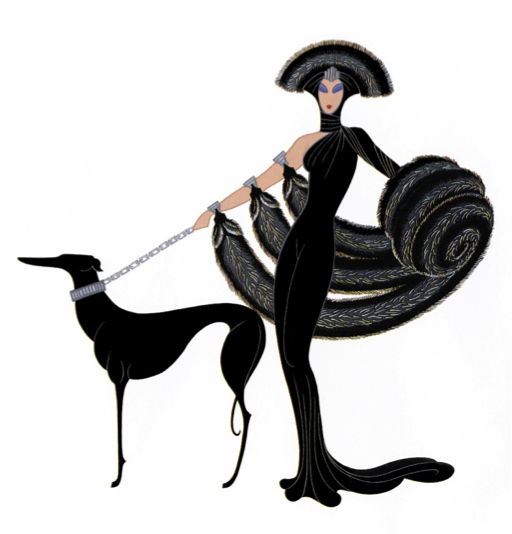
Those enthusiastic about Russian art will be familiar with the stock names associated with stage and costume design; Goncharova, Larionov, Bakst, even Malevich on occasion. ‘Erté’, however, may not ring so loud a bell. A prolific costume designer, he was one of the finest fashion illustrators of the early twentieth century.
I regret to say that I had never come across him until I was looking into the history of Harper’s Bazaar magazine. It turns out that this popular publication had a 22 year relationship with Erté, who was responsible for producing over 240 iconic covers for the magazine. His elaborate designs put Harper’s Bazaar at the forefront of creative innovation. For someone interested in both art and fashion like myself, Erté’s designs are a pure delight. He managed to perfectly capture the elegance and simplicity of the female silhouette, all the while combining it with an art deco aesthetic. How lovely to think that such a magazine once relied on original hand-drawn illustrations to sell itself (a sharp contrast to today’s unanimous choice of a close up of the celebrity-du-jour’s expressionless face).
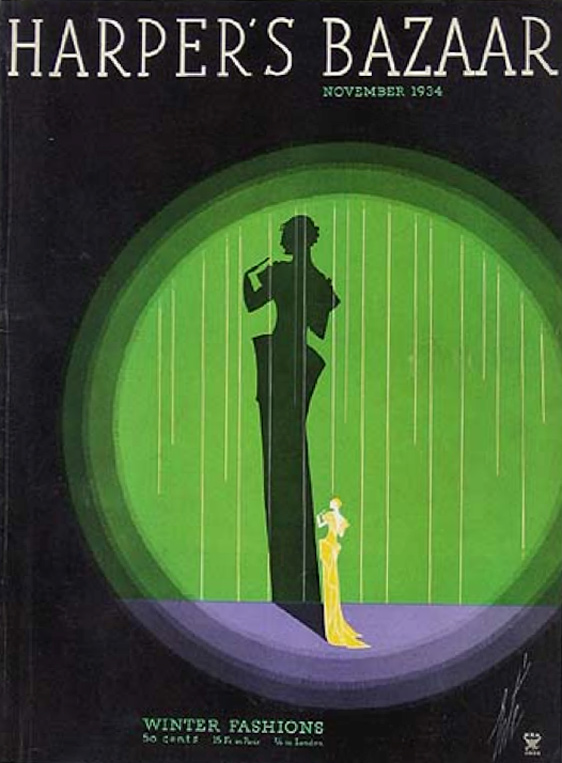
Erté’s cover design for the November 1934 issue of Harper’s Bazaar
Born in St Petersburg in 1892, Romain de Tirtoff was raised amidst the social elite. His father owned a collection of Persian miniatures and it was perhaps this exposure to bright and exotic patterns from a young age that shaped his distinctive style in years to come. In 1912, set on becoming a fashion illustrator, Tirtoff moved to Paris (where he took the name ‘Erté’ from the French pronunciation of his initials). He was quickly hired soon after by then-leading couturiers Paul Poiret, under whom he mastered his craft and gained an international reputation as one of the world’s leading fashion illustrators. It appears few where surprised when in 1915 he signed a contract with Harper’s Bazaar, who he would carry on working with until 1937.
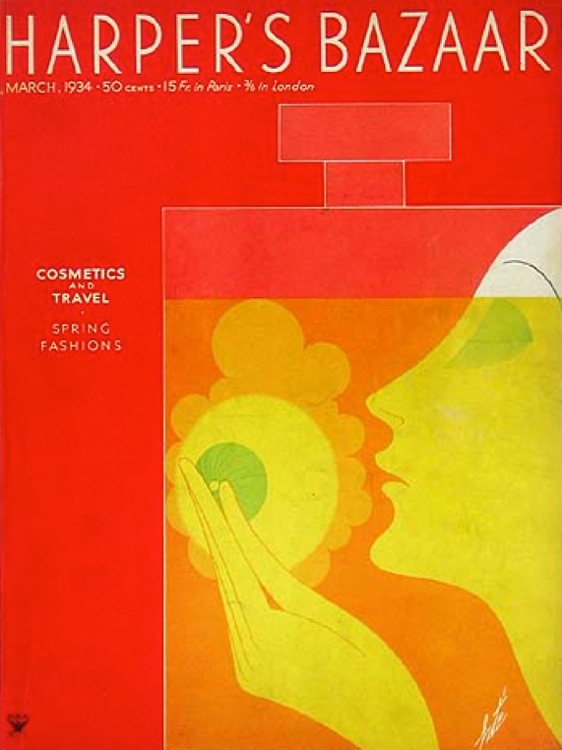
Erté’s cover design for the March 1934 issue of Harper’s Bazaar
While still working for the magazine, Erté had a successful career during the 1920s and 30s as a costume designer for productions at Paris’s Folies Bergère, and on New York’s Broadway. Even Hollywood came calling, asking Erté to design costumes for the epic ‘Ben Hur’ and ‘The Mystic’, among others. His vibrant and elaborate designs drew on influences from Russian icon painting to Greek and Egyptian motifs, although some might argue he owed a lot to Leon Bakst.
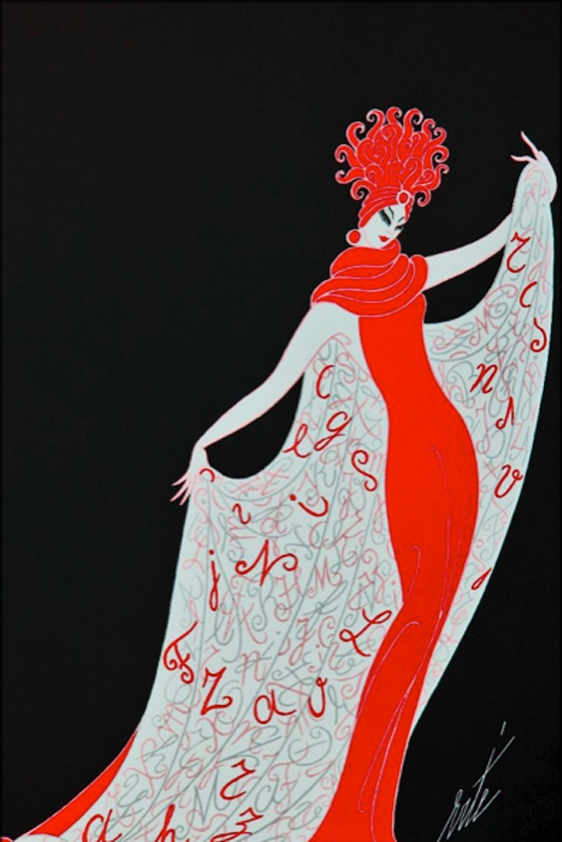
‘Alphabet Cloak’, lithograph, Erté
Erté’s figures, lithe and swathed in furs, came to define the opulence and luxury of his time. He was awarded the title ‘Officer of Arts and Letters’ by the French Government in 1976, and many of his designs became popular posters. In later years his work inspired collections from designers such as Yves Saint Laurent and Oscar de la Renta. Today examples of his work can be found in the collections of institutions such as the Metropolitan Museum of Art, Los Angeles County Museum of Art, and the V&A. Erté died in 1990, aged 97.
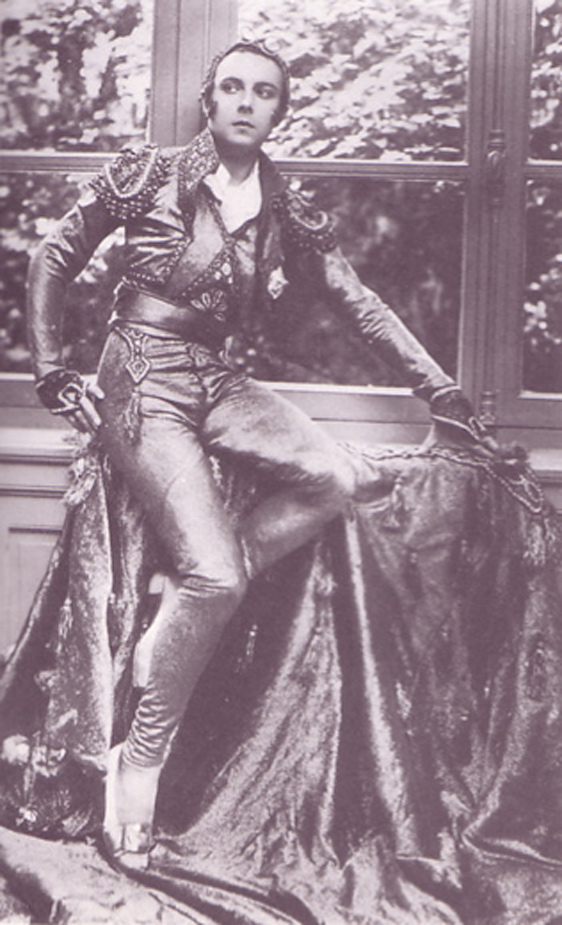
Erté sporting one of his own bullfighter costume designs


